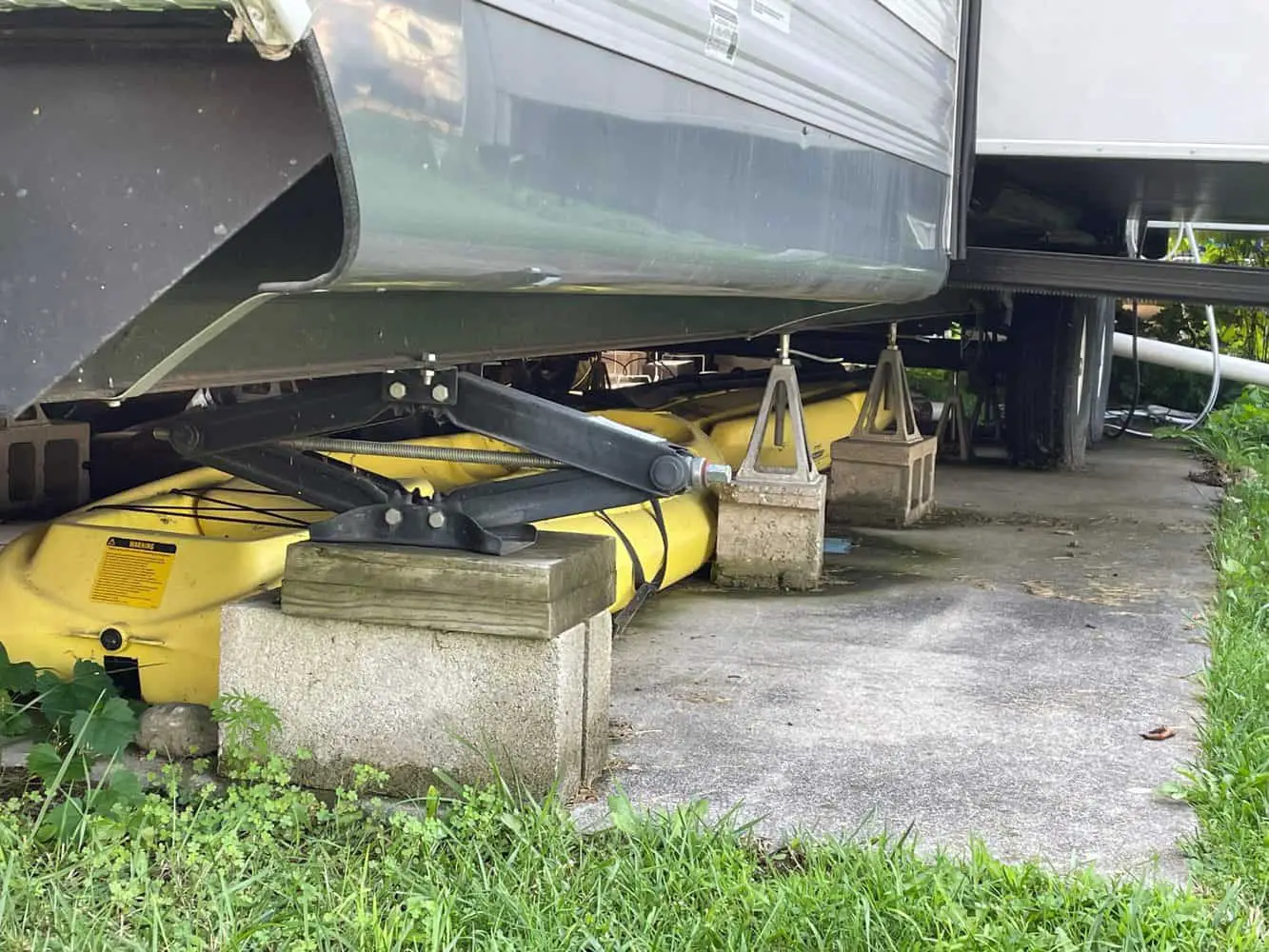If you’re wondering whether it’s possible to level a travel trailer on a permanent site, the answer is yes. In this guide, we’ll take you through all the steps so you’ll know exactly how to do it when the time comes.
Setting up a trailer requires a strong dose of patience, in addition to know-how. There’s a definite learning curve involved.
Even though I’ve done it multiple times, I’m always looking for new ways to improve my technique. I’ve put together this guide to offer readers the benefit of my experience. With any luck, it will help you avoid some of the most common rookie mistakes.
Here’s what you can expect to learn from this tutorial:
- Why proper leveling is important
- How to choose the right site
- How to get the site ready for your trailer
- Step-by-step instructions on how to level a travel trailer
Why It’s Important
Anyone who’s ever slept in a listing travel trailer can tell you that it’s no fun. If the RV tilts too far in a certain direction, it can interfere with your ability to get a good night’s sleep. Even a slight angle can cause objects to roll the length of the trailer when dropped on the floor, or disrupt the flow of water in the sink or toilet.
Uneven trailers can also cause undue stress on the camper’s frame. You want to make sure the weight is distributed evenly. Otherwise, the chassis will wear down over time.
An RV that lists to the side can be dangerous in ways you might not have considered. Restless sleepers have been known to roll right out onto the floor when the trailer wasn’t leveled properly. The angle could also affect the water reservoirs, limiting your freshwater access and giving you false readings on gray and black water tanks.
In short, this step is crucial even when you’re setting up the camper for a night or two. But if you’re a seasonal RVer who wants to set up the rig in a permanent spot for the whole summer, it becomes even more important.
Choosing A Permanent Site
Let’s start with the bad news: It can be hard to find a spot for your trailer that’s perfectly even.
Some RV parks offer sites that are designed specifically for permanent use. These usually feature concrete slabs, which means that the ground is as flat as possible. Off-grid campers, meanwhile, will have a more difficult go of it.
Keep your eyes peeled for a large stretch of even ground. It will save you time if the area is also free of debris, since you’ll need to clear the area before parking the RV.
Once you’ve found a spot that looks suitable, walk across the ground to determine how stable it is. If the soil isn’t firm enough to support your weight, you can’t expect it to be a feasible parking spot for your RV.
Preparing The Site
When you camp in remote areas, fallen branches and pine cones come with the territory. However, your job will be much easier if you clear any debris from the spot you plan to use.
Seasonal hazards like piles of leaves and dropped acorns might not look like much from a distance, but when you’re setting up a permanent site for your camper, they can pose a real problem. You need the ground to be as flat and even as possible before you begin. Grass, dirt, and/or concrete should be the only things you see on the ground of your campsite.
As for the area overhead, make sure there are no long overhanging branches that might interfere as you back up the camper. If there are, you’ll need to trim them and remove them from the area ahead of time.
In addition, we would recommend getting the trailer set up and leveled before you unpack any other gear. The grill, bicycles, and kayaks can stay where they are until your home-away-from-home is comfortably ensconced in your chosen spot.
Notes For Parking On Ice
While most people will be setting up camp during the warmer months, similar rules apply when it comes to parking a trailer for ice fishing. However, if you’re setting up an “ice castle” trailer for this seasonal activity, you’ll need to take a few extra precautions.
First of all, make sure the ice is thick enough to support your trailer’s weight. A minimum thickness of 12 inches is recommended for heavy-duty trucks or any load weighing around 16,000 pounds. We would suggest using this as a guideline, even if your trailer weighs significantly less.
Look for a stretch of ice that hasn’t been used as a fishing spot yet. The smoother the surface, the easier it will be to maneuver your ice castle into place. It’s fine to drill a few holes to test the area, but try not to leave any chunks of ice or slush on the surface.
Use a plow to clear the area of snow, making sure to go all the way down to the ice. If you don’t have a plow available, use a shovel. Don’t leave any slushy spots, as these will create bumps on the ice when the slush refreezes.
Remember to lay down panels of plywood if you don’t have leveling blocks (see the step-by-step guide below for more details). Otherwise, your tires might freeze into place due to variations in the weather.
How To Level A Travel Trailer On A Permanent Site: A Step-By-Step Tutorial
1. Select Your Site
Obviously, you’ll want to choose a site that’s large enough to accommodate your travel trailer. It’s also important for the ground to be as flat as possible. If you’re already starting on uneven ground, your job will be much harder than it needs to be. Once you’ve found the ideal site, clear it of all debris.
2. Check The Trailer
Before you set up your unit in a permanent spot, you’ll want to use a level to determine the orientation of the trailer itself. Chances are good that it isn’t perfectly level, but knowing which way it tilts will improve your chances of success.
3. Set Up Leveling Blocks
Place leveling blocks in front of each tire on the side that’s in need of adjustment. The blocks will create makeshift ramps for each tire.
If you don’t have leveling blocks, you can create a facsimile using quality pressure-treated lumber. Since the wood will absorb moisture and even begin to rot over time, we don’t recommend this if you’re going to park the trailer in the same site for longer than 3 months. For shorter stays, however, it should do the trick.
Also note that leveling blocks are a must if you’re parking on unstable terrain. Unless your permanent site has a concrete base, don’t swap out the blocks for wooden substitutes.
4. Move The Trailer
Ask a friend or family member to stand outside while you carefully drive the trailer onto the leveling blocks. This works even better if you have two people helping you, so one can stand on each side.
Back onto the blocks slowly, trying not to move too far in either direction. The tires should be positioned entirely within the blocks. If any part of the tire is hanging over the edge of the block, you’ll need to start over.
5. Position The Wheel Chocks
Set the wheel chocks against the tires, wedging them firmly into place on whichever side isn’t quite even. You should chock both sides of each tire, but it’s more important to wedge them tightly on the uneven side.
6. Lower The Tongue Jack
Set a paving stone on the spot where the tongue jack will land. This helps to keep the jack from sinking into the ground during longer storage periods. If you have any pressure-treated wood on hand, you can use that instead.
Place your level in a spot near the middle of the RV. Ask a friend to watch the bubble as you carefully lower the tongue jack. If you’ve done the job properly so far, the bubble should remain in the center.
7. Unhitch The Tow Vehicle
When you’re satisfied with your work, unhitch the vehicle and move it a safe distance away. You still have some fine-tuning to do, and it will be easier if the vehicle is out of the way.
Check the level once more to find out if you need to adjust the front-to-back positioning of your trailer. If it shows that the rear of the trailer is too low or too high, adjust the tongue jack until it evens out.
8. Install The Stabilizing Jacks
If you’re planning on parking the RV in a permanent site, you should invest in a set of stabilizing jacks. These should be positioned beneath each corner of the rig to keep it from shifting from side to side while it’s parked.
When you use stabilizing jacks, you’ll be taking a great deal of pressure off the tongue jack. As a bonus, the trailer will be less prone to those annoying squeaking noises that can sometimes happen when you move around inside.
These parts come standard with many RVs. If yours doesn’t have them, you can pick them up at your local automotive supply store. Remember that you can’t use stabilizing jacks to raise the trailer, only to hold it in place one you’ve already lifted it.
In Conclusion
The main thing to remember when choosing a permanent site is to look for a clean, flat surface. If the area contains debris that can’t be easily hauled away, look for another spot that’s large enough to accommodate your rig.
You should also invest in quality equipment. Often, the right blocks and stabilizing jacks can mean the difference between success and frustration. You’ve already invested time and money in this camper—take this extra step to protect your investment.
Good luck, and happy camping!
Check out our article on: How To Stop A Travel Trailer From Rocking? (9 Step Guide)

